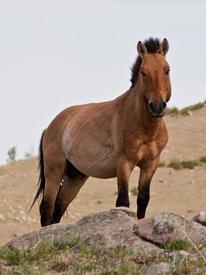
Named after the man responsible for its official discovery, explorer and naturalist Nikolai Przhevalsky, the Przewalski Horse is considered the world’s last example of a wild horse subspecies. Never domesticated, the breed was first observed in the 15th century, although it was not seen again until Przhevalsky’s discovery some centuries later.
Native to Mongolia, the existence of the distinctive Przewalski’s Horse has been threatened at points in its history due to inbreeding, loss of resources and habitat, and hunting practices.
It is estimated that only 12 horses remained by the 1950s and global foundations for preservation were established to try and protect the breed from extinction. In 1992, 16 Przewalski’s horses were returned to the wild, although the majority can still be found in captivity.
The breed is known by several different names including the Mongolian Wild Horse, the Tahki (meaning ‘spirit’ in Mongolian), and the Asian Wild Horse. Characteristically, the horse has short legs, a stocky well-balanced conformation, and an erect mane that is usually dark. Typical coat colours range from dun to pale brown, and light striping is often found on the legs.
Although these horses are native to Mongolia, they could once be found in Germany, Poland, Ukraine, Lithuania, Belarus, Russia, China and Kazakhstan.
Domestic horse species all have 64 chromosomes; however, the Przewalski’s Horse has 66.
Do you own a Przewalski's Horse? Let others know what they're like!
Related products
Advantage 80 Spot On Flea Control Large Cats and Rabbits
from £10.89
Advantage 40 Spot On Flea Control Cats, Small Dogs and Rabbits
from £10.89
Advantage 100 Spot On Flea Control Medium Dog
from £10.89
Drontal Tasty Bone Wormer Tablets for Small & Medium Dogs (2 to 20kg)
from £1.83
Advantage 250 Spot On Flea Control Large Dog
from £10.89
FRONTLINE Plus Flea & Tick Treatment Dogs & Cats
from £17.49
TermaWorm™ Tablets for Cats & Dogs
from £1.59
Drontal Tasty Bone XL Wormer Tablets for Large Dogs (Over 20kg)
from £5.43